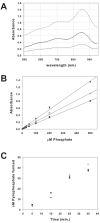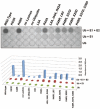A spectrophotometric assay for conjugation of ubiquitin and ubiquitin-like proteins
- PMID: 21771579
- PMCID: PMC3178097
- DOI: 10.1016/j.ab.2011.06.034
A spectrophotometric assay for conjugation of ubiquitin and ubiquitin-like proteins
Abstract
Ubiquitination is a widely studied regulatory modification involved in protein degradation, DNA damage repair, and the immune response. Ubiquitin is conjugated to a substrate lysine in an enzymatic cascade involving an E1 ubiquitin-activating enzyme, an E2 ubiquitin-conjugating enzyme, and an E3 ubiquitin ligase. Assays for ubiquitin conjugation include electrophoretic mobility shift assays and detection of epitope-tagged or radiolabeled ubiquitin, which are difficult to quantitate accurately and are not amenable to high-throughput screening. We have developed a colorimetric assay that quantifies ubiquitin conjugation by monitoring pyrophosphate released in the first enzymatic step in ubiquitin transfer, the ATP-dependent charging of the E1 enzyme. The assay is rapid, does not rely on radioactive labeling, and requires only a spectrophotometer for detection of pyrophosphate formation. We show that pyrophosphate production by E1 is dependent on ubiquitin transfer and describe how to optimize assay conditions to measure E1, E2, and E3 activity. The kinetics of polyubiquitin chain formation by Ubc13-Mms2 measured by this assay are similar to those determined by gel-based assays, indicating that the data produced by this method are comparable to methods that measure ubiquitin transfer directly. This assay is adaptable to high-throughput screening of ubiquitin and ubiquitin-like conjugating enzymes.
Copyright © 2011 Elsevier Inc. All rights reserved.
Figures






References
-
- Pickart CM, Eddins MJ. Ubiquitin: structures, functions, mechanisms. Biochim Biophys Acta. 2004;1695:55–72. - PubMed
-
- Deshaies RJ, Joazeiro CA. RING domain E3 ubiquitin ligases. Annu Rev Biochem. 2009;78:399–434. - PubMed
-
- Chen ZJ, Sun LJ. Nonproteolytic functions of ubiquitin in cell signaling. Mol Cell. 2009;33:275–86. - PubMed
Publication types
MeSH terms
Substances
Grants and funding
LinkOut - more resources
Full Text Sources
Other Literature Sources
Molecular Biology Databases
Research Materials

